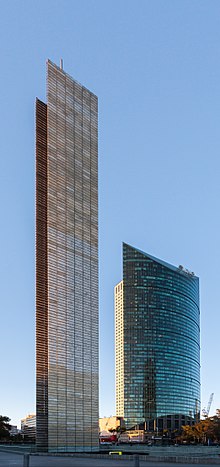Estela de Luz
("Stele of Light") | |
 "Estela de Luz" monument and the Torre Mayor in the background | |
 | |
| 19°25′23″N 99°10′33″W / 19.423048°N 99.175857°W | |
| Location | Avenida Paseo de la Reforma at easternmost end of Chapultepec Park (Calle Lieja) |
|---|---|
| Material | quartz |
| Height | 104 meters (341.2 feet) |
| Beginning date | September 22, 2009 |
| Completion date | December 31, 2011 |
| Opening date | January 7, 2012 |
| Dedicated to | Bicentennial of Independence/Centennial of the Revolution |
The Estela de Luz (Stele of Light) is a monument in Mexico City built in 2011 to commemorate the bicentenary of Mexico's independence from Spanish rule. Its design was the winning entry in an invited competition to seek the best combination of Mexico's past and future;[citation needed] the design uses quartz and electric lighting to achieve this effect.[1] The main use of the Estela De Luz will be for cultural events.
The monument is popularly known as the suavicrema (a brand of ice cream wafer) due to the resemblance on its shape to said wafer.[2]
Criticism
The Estela de Luz was criticized for being built late for the main ceremonies and for exceeding the estimated costs by almost three times. Officials noted that the structure needed to be reinforced against earthquakes, similarly to that of the Torre Mayor. This reinforcement, coupled with conflicts between the architect and the construction company, were major reasons for the additional time and expense.[3] Two months after the January 2012 inauguration, the Estela de Luz was tested by the 2012 Guerrero–Oaxaca earthquake, which it withstood, along with other tall buildings in the area.[citation needed]
References
- ^ Hernandez, Daniel (August 17, 2010). "Bicentennial tower monument delayed in Mexico". Los Angeles Times. Retrieved March 23, 2012.
- ^ "Cinco datos que debes conocer de la Estela de Luz" (in Spanish). El Universal. November 11, 2019. Retrieved July 9, 2020.
- ^ "La Estela de Luz de la Ciudad de México es inaugurada" (in Spanish). CNN Mexico. January 7, 2012. Retrieved March 23, 2012.
External links
 Media related to Estela de Luz at Wikimedia Commons
Media related to Estela de Luz at Wikimedia Commons
